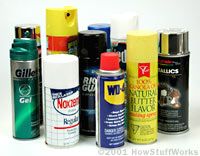A Few Words About Fluids
The basic idea of an aerosol can is very simple: One fluid stored under high pressure is used to to propel another fluid out of a can. To understand how this works, you need to know a little about fluids and fluid pressure.
- A fluid is any substance made up of free-flowing particles. This includes substances in a liquid state, such as the water from a faucet, as well as substances in a gaseous state, such as the air in the atmosphere.
- The particles in a liquid are loosely bound together, but they move about with relative freedom. Since the particles are bound together, a liquid at a constant temperature has a fixed volume.
- If you apply enough energy to a liquid (by heating it), the particles will vibrate so much that they break free of the forces that bind them together. The liquid changes into a gas, a fluid in which the particles can move about independently. This is the boiling process, and the temperature at which it occurs is referred to as a substance's boiling point. Different substances have different boiling points: For example, it takes a greater amount of heat to change water from a liquid into a gas than it does to change alcohol from liquid to gas.
- The force of individual moving particles in a gas can add up to considerable pressure. Since the particles aren't bound together, a gas doesn't have a set volume like a liquid: The particles will keep pushing outward. In this way, a gas expands to fill any open space.
- As the gas expands, its pressure decreases, since there are fewer particles in any given area to collide with anything. A gas applies much greater pressure when it is compressed into a relatively small space because there are many more particles moving around in a given area.
An aerosol can applies these basic principles toward one simple goal: pushing out a liquid substance. In the next section, we'll find out exactly how it does this.
Advertisement
